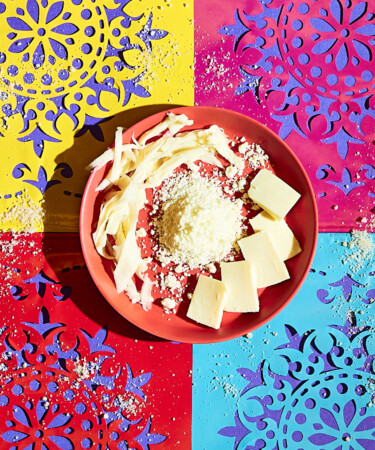Carlos Yescas, author of “Quesos Mexicanos,” has identified around 60 kinds of cheeses being made in Mexico today. These are cheeses made with cow milk, goat milk, and sheep milk in a range of styles. You can find bloomy rinds, meaty funky washed rinds, as well as harder varieties.
Sadly, these cheeses rarely make their way across the border into the U.S. “There is basically no Mexican cheese outside of Mexico,” Yescas explains. This, he says, is due to strict regulations as well as the American expectation that products from Mexico be cheap. The “Mexican cheeses” you’ll find in the United States are more accurately described as Mexican-style cheeses.
As far as what most Mexicans are eating on a regular basis, there are four cheeses that make up the canon. All are on the younger side and are made with cow’s milk. And, don’t bother putting them on your cheese board, Yescas says — they primarily function as cooking cheeses.
“If you’re trying to eat these cheeses on a cheese board, they will always pale in comparison,” Yescas says. “The ultimate point of gastronomy is not the grazing board, it’s understanding the everyday use of these ingredients.” Instead, he explains, these are intended as ingredients in complex recipes, as one flavor of many.
Even though you won’t find true Mexican cheeses in the United States, Yescas says, the versions you can find in your local market are going to be fairly similar quality to what most Mexicans are eating on a daily basis. But, he adds, if you’re going to splurge on cheeses for your cheese board, it’s also worth splurging for your dinner cheese.
I think we can agree that if I’m going to make a quesadilla at home, it will be better if it’s made with heirloom corn, grown by a farmer who was paid fairly for production,” Yescas says. “Cheese made from milk from animals whose welfare was valued, and whose milk was handled well will taste better.” If you see versions of these cheeses at your local farmer’s market or specialty store, it’s worth snatching them up.
Here are the four Mexican staple cheeses to consider keeping around.
Queso Oaxaca
If you were to quickly glance at a round of Queso Oaxaca, sometimes called Quesillo de Hebra, you might mistake it for a ball of fresh mozzarella. And you wouldn’t be too far off: This cheese is also made in the pasta filata style, in which fresh cheese curd is stretched, pulled, and woven back into a cohesive format. In this case, though, it’s meant to look more like a ball of yarn than a smooth ball. Pulled directly off the wheel like string cheese, this cheese is lactic, tangy, and amazing for melting. Use Queso Oaxaca for quesadillas or empanadas.
Queso de la Panela
In Mexico, you’ll sometimes find this sold as Queso de Canasta. Canasta, meaning basket, refers to the basket-shaped mold the cheese is drained in, which gives the cheese its shape. Though this cheese was made with goat milk many years ago, it’s now almost exclusively a cow milk cheese. It’s sweet and salty, and holds its shape even if it’s been cooked. Queso de La Panela is great in tortas, enchiladas, and for stuffing chiles. Though you can find more aged versions of this cheese in Mexico, it’s almost always sold as a young cheese in the United States.
Queso Cotija
“Cotija is weird,” says Yescas, “because there is a regional Cotija made in the mountains that’s amazing.” Also called Cotija de Origen, this cheese is made from the raw milk of cows grazing on the rich pastures of the Jalmich mountains in central Mexico and is noted for its umami and hay-like flavors. “Even most Mexicans don’t know it.” What is much more common is white, salty, pasteurized Cotija. Intended as a cheese to provide one last salty hit of flavor, it’s great over refried beans, tacos, chilaquiles, or elote.
Queso Chihuahua
In the Northern Mexican state of Chihuahua, you’ll find a soft melting cheese called Queso Menonita, named after the Dutch and German Mennonite immigrants who moved to Chihuahua in the 1920s and brought this style of cheese with them. Elsewhere in Mexico and throughout the U.S., you’ll more often find it called Queso Chihuahua. Similar to Monterey Jack or a young Cheddar, it’s a great snacking cheese as well as a melting cheese. Use it in queso fundido, quesadillas, or just put it on a cracker and eat it.
